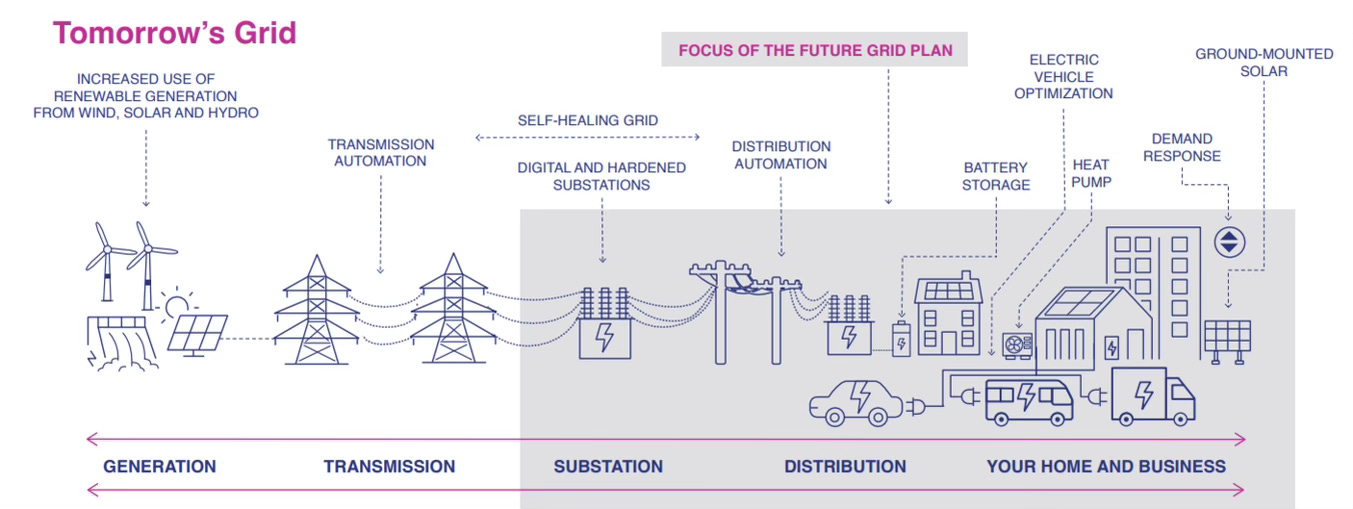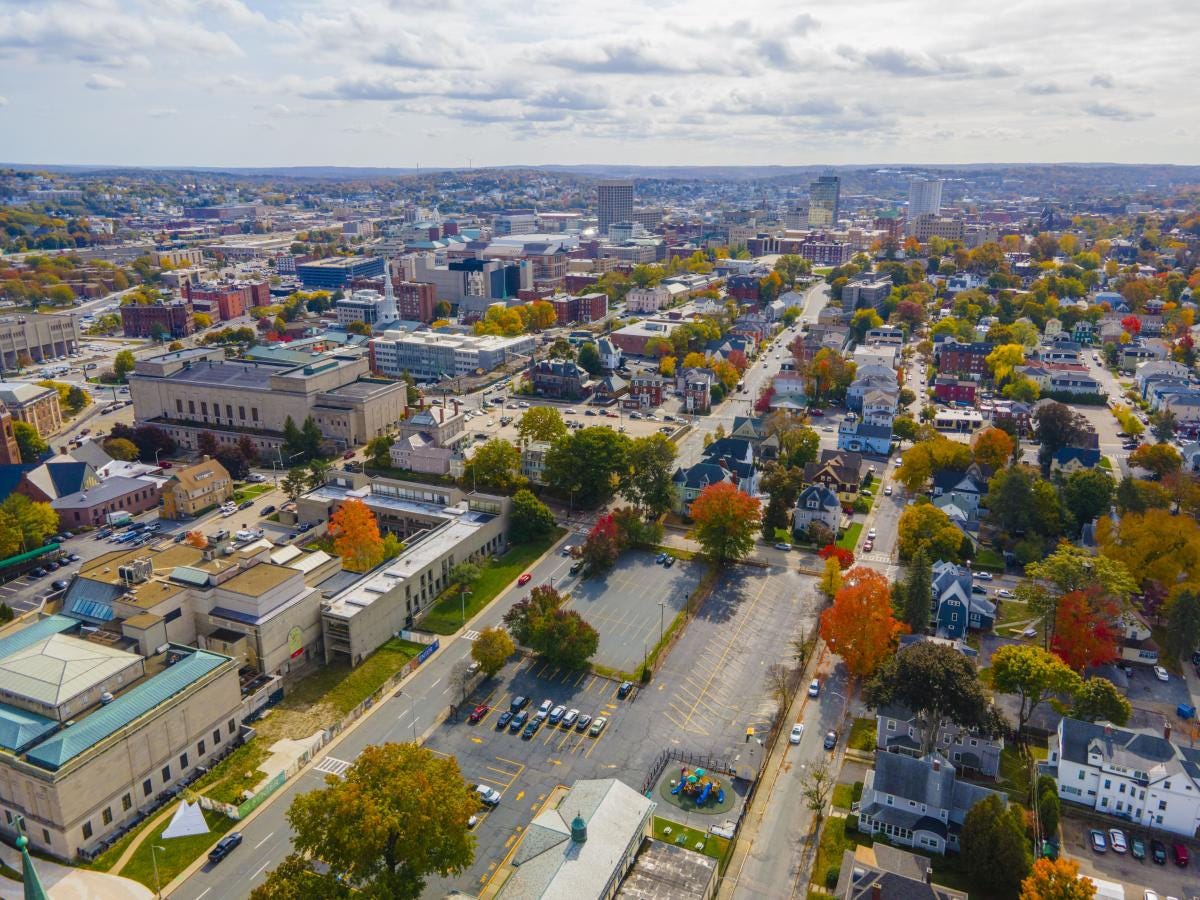The Massachusetts Grid Modernization Advisory Committee is Lying About Their Intentions
Climate activists cannot proudly name their ideology—why not?
In December 2024, the Massachusetts Grid Modernization Advisory Council (GMAC) released some nifty factsheets and digital materials that seek to explain what Massachusetts has planned for the grid of the future. The core interface is a neat ArcGIS infographic that explains what the grid is, what the grid will be, and how it’ll happen. GMAC also provide a Grid Modernization 101 and 102 pair of one-page flyers that respectively offer a strategic and operational look at grid modernization. The flyers are printed in English, Spanish, Simplified & Traditional Chinese, Haitian Creole, Portuguese, and Vietnamese (the languages that matter in Massachusetts), and the graphics are unremarkably excellent.

This is, in sum, a good math-free explanation of the decarbonized energy transition, presented at the sixth-grade reading level that customers need. It looks like Beacon Hill has a strong idea about how we need to get from the fossil-fueled today to the carbon-free tomorrow.
The problem is that they’re lying by omission about what it will take.
Decarbonization Is an Ideological Goal
The challenge with explaining decarbonization is that the honest reasons for total carbon reduction are inherently ideological. This is a problem in the United States, because—as CCP grey eminence Wang Huning has attested—ideology is not part of the American national character. The default American approach is a pragmatic “what works best?” and in the absence of better metrics, we default to revenue growth at the micro scale and GDP growth at the macro scale. As a result, climate activists (especially the technocratic ones) frequently frame their arguments for decarbonization in economic terms—energy adequacy, long-term resilience, mitigating damage from natural disasters. The problem is that the serious decarbonization they want costs more (in USD) than the benefits (in USD) one would get, short of placing a number on priceless intangibles like carbon emissions or biodiversity loss.
If you truly believed in climate action for economic reasons, you would:
Replace coal and oil with natural gas wherever possible
Simplify, shrink, and/or onshore supply chains
Scale up renewables where it’s cost-competitive (RECs don’t count)
Scale up resiliency and climate adaptation efforts: Air conditioning, stormproofing, propane gensets, controlled wildfire burns, desalination
This would insulate the country from the worst climate scenarios, without impoverishing anyone. Asking for anything further requires you to argue that decarbonization is worth paying for.
Now, that’s fine. An ideology is simply a set of values that you consider worth paying for—in fact, humans have a track record of paying for their ideologies with their lives. And if you wouldn’t pay for your moral values, then they weren’t your values in the first place.
But American climate activists seem incapable of making an ideological argument—instead of saying “decarbonization is worth the price,” they lie about what that price really is.
GMAC, Briefly
GMAC is a committee formed by the 2022 Massachusetts Climate Law. Its main job is to review electric-sector modernization plans (ESMPs) from the three investor-owned electric distribution companies (EDCs)—Unitil, Eversource, and National Grid. The idea is that because decarbonizing the grid will require modernizing the grid, the EDCs should let the State House know what they will do and how much it will cost. In practice, this is how Beacon Hill holds the EDCs to account—if no one’s looking, the EDCs will absolutely slow-walk grid hardening because their investors do not necessarily believe that decarbonization is worth paying for.
GMAC does—their voting members include stakeholders from the Massachusetts state government, energy advocacy groups, renewable energy interest groups, and a couple of technical experts. Everyone on GMAC thinks decarbonization is worth paying for—or else knows that decarbonization would pay them. The EDCs have non-voting member seats, either as quiet sanity checks or as messengers to shoot. Notably, GMAC has no direct contact with ISO-NE or anyone would touch the wholesale energy market. This is probably fine, because GMAC’s mandate does not touch generation.
I have hung out in the same circles as the people on GMAC. They have a distant-to-adversarial relationship with the EDCs, and they only speak to integrated energy and customer service staff—not transmission or distribution engineers.
What GMAC Thinks Must Happen
The GMAC vision of the grid is based on a 2050 Decarbonization Roadmap written in 2020 by the consulting firm Cadmus. If you dig through LinkedIns, you’ll find three people on the GMAC board worked for Cadmus when the roadmap was written. In fact, the backup designee for the GMAC chair is a named author on that report. This is an insular group of people.
At a strategic level GMAC wants what we all want—to improve grid reliability in a changing climate, to decarbonize that grid, to accommodate electrification, and to “minimize or mitigate impacts on ratepayers.”
The top-level estimation is that decarbonizing Massachusetts will require electrifying everything, which will require doubling the electric generation of the grid. That’s generation in MWh, not capacity in MW. This mismatch is only a problem if you care about when the energy shows up. I do, but current regulatory thinking does not. To meet this challenge, GMAC is looking at five suites of technology:
Thermal electrification—in particular, electric air source heat pumps
Solar generation—both distributed (kW-scale) and grid-scale (MW-scale)
Electric vehicles—mostly light-duty for now
Offshore wind—the commonly-assumed cavalry for renewable generation in New England
AMI metering and the “smart grid”—readers outside of New England would find that we’re bizarrely behind on AMI rollout
Notably, GMAC does not talk about onshore wind, nuclear energy, or industrial electrification (in particular laboratory steam). Instead, they presuppose that distributed energy resource (DER) integration—small solar systems, electric vehicles, smart thermostats—are the approach to take. I have questions about the cart-horse integration in this plan.
I’ll also note that this 2050 roadmap is pre-IRA, pre-CHIPS and Science, pre-ChatGPT. “Industrial policy” wasn’t a hot term at the time. However, Massachusetts has never been considered an ideal location for industrial buildout (even for data centers), so that double-load estimate should hold. Expect 3-5x load growth in the Sun Belt, though.
The Utilities Didn’t Get the Memo
GMAC’s infographic links to the electric-sector modernization plans that the utilities provided, as well as—more embarrassingly—GMAC’s comments in November 2023. The problem is that GMAC and the EDCs misread each other.
GMAC are qualitative, customer-facing, ideological analysts. They wanted a confirmation that the EDCs will do what the 2022 Climate Law asked, as well as some metrics for what they would spend, how they would spend it, and when they would “talk to stakeholders” (i.e. let activists grill them at 6PM on a Wednesday). The EDCs asked their quantitative, accountant-facing, technical analysts to write these plans. They gave a rundown of projected capital expenditures from 1 Jan 2025 to 31 Dec 2029, based on technologies and load forecasts they were already using.
It wasn’t a match. The reports were too technical for the GMAC staff to follow. They did not follow a common format, forecasting methodology, or definition of technical terms. They didn’t look at the piloted-but-unproven-at-scale “non-wire alternatives” GMAC wants, like dynamic rates, distributed energy storage, and “smart-grid” networking and forecasting technologies. They didn’t consistently differentiate DPU-approved investments from “we might need a wire here.”
And most importantly, the utilities did not promise that this grid modernization won’t increase electric bills for low-income customers.
The Bad News
I come from the same cohort as the GMAC board. I, too, struggled to read the modernization plans. So I jumped to the cost estimates for this blog post.
National Grid has 1.3 million electric customers, and they plan to spend $2 billion between 2025 and 2029, inclusive. That comes out to $300 per customer per year, or $25 per customer per month.
Eversource has 1.47 million electric customers, and they plan to spend $6 billion between 2025 and 2029, inclusive. They claim:
The grid currently has very little electrification hosting capacity to reliably support electrification and clean energy resources in all communities.
Their spend plan comes out to $800 per customer per year, or $65 per customer per month.
Unitil has 26,500 electric customers, and they plan to spend $133 million between 2029 and 2029, inclusive. One-third of that spending has not been approved by the DPU, so it may not happen. Including the proposed costs, that comes out to $1000 per customer per year, or $80 per customer per month.
Figure that distribution costs are about one-third of your electric bill. Just investment up to 2030 could double distribution charges, if the EDCs don’t amortize these costs. In practice, they would spread these investments over twenty years, so they can make more investments from 2030 to 2034, and yet more from 2035 to 2039, so that your distribution charges don’t double yet. The EDCs must decide how they distribute these extra costs between residential and commercial customers, and between low-income and high-income customers. But ultimately, the customers have to pay for grid modernization.
And that’s before we get to wholesale electricity costs. Remember, ISO-NE projects that energy costs will become more volatile, that capacity costs will spike, that the wholesale fuel and capacity costs that currently comprise about half your electric bill will quintuple by 2045:
What Will It Take to Decarbonize the Grid?
Between 2022 and 2024, ISO New England (ISO-NE) ran a comprehensive study to ask—seriously, soberly—what it would take to decarbonize the electric grid.
GMAC’s vision would electrify your house, too. Figure that’s a doubling of your kWh, as your cost per kWh doubles in parallel by 2040 and potentially quadruples by 2050.
Nothing available today will protect consumers from these cost increases. This is the price we must pay for decarbonization. Sending me a link to some wunderklimatechnik you saw on LinkedIn misses the point, as do charts of exponentially-falling costs of solar and lithium storage systems, because utilities need to invest the capital today. I have spoken to people on the GMAC board: they’re decent and intelligent people. But they’re ideologues, and they’re lying by pretending otherwise.
Total decarbonization is an ideological goal.
Making it happen will be expensive.
I want decarbonization activists to look me in the eye, admit that it will be expensive, and then tell me it’s worth the price.
This post and the information presented are intended for informational purposes only. The views expressed herein are the author’s alone and do not reflect those of their current or previous employers or any elected officials. The author makes no recommendations toward any electric utility, regulatory body, or other organization. While certain information contained herein has been obtained from sources believed to be reliable, the author has not independently verified this information, and its accuracy and completeness cannot be guaranteed. Accordingly, no representation or warranty, express or implied, is made as to, and no reliance should be placed on, the fairness, accuracy, timeliness or completeness of this information. The author assumes no liability for this information and no obligation to update the information or analysis contained herein in the future.



